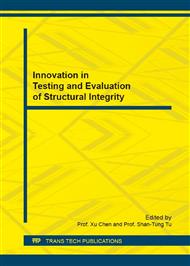p.493
p.498
p.503
p.508
p.514
p.519
p.524
p.529
p.534
Development of Bending and Torsion Fatigue Testing Machine for Multiaxial Non-Proportional Loading
Abstract:
This study presents a newly developed multiaxial high cycle fatigue testing machine which can load a cyclic bending loading and a reversed torsion loading onto an hour-glass shaped solid bar specimen. This testing machine can perform the fatigue tests with a high frequency under a proportional and a non-proportional loading conditions. In the non-proportional loading, principal directions of stress and strain are changed in a cycle. In the testing machine, the loading is generated by centrifugal force caused by the revolving weights attached to rotational wheels. The maximum frequency of the testing machine is 50Hz. A material tested was a type 304 stainless steel. In the test, two types of loading paths are employed, a proportional loading and a non-proportional loading. The former is a cyclic bending loading and the latter a combining cyclic bending and reversed torsion loading in the developed testing machine. In this study, an applicability of the testing machine is evaluated by carrying out the tests under these loading conditions.
Info:
Periodical:
Pages:
534-538
Citation:
Online since:
September 2016
Authors:
Price:
Сopyright:
© 2017 Trans Tech Publications Ltd. All Rights Reserved
Share:
Citation:


